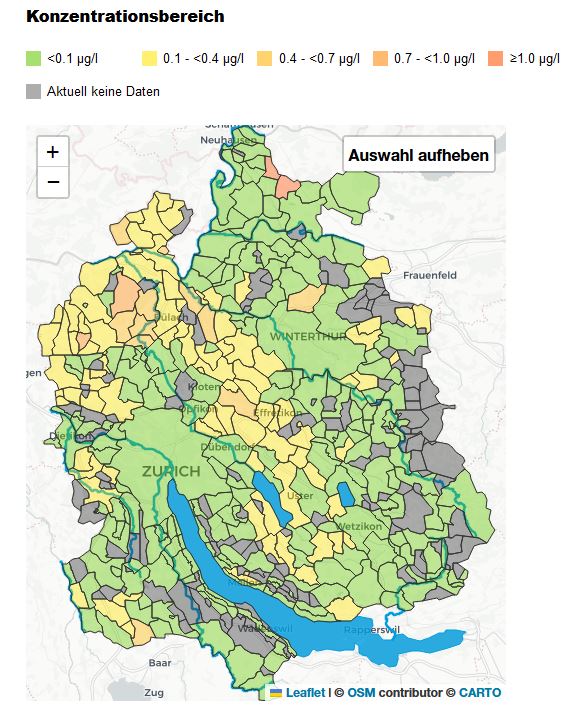- Water tests
- Air quality and pollutants
- Mold analyses
- Asbestos analyses
- Rapid tests
-
Knowledge
- Analysis made easy
- Facts About Drinking Water
- Facts about Indoor Air
- Facts about Mold
- Facts about Asbestos
-
Water quality in Switzerland
- Further current news
- NEWS: Zurich Drinking Water Map
- Water Scarcity and Water Quality
- The Water Supply of the City of Thun
- Drinking Water in St. Gallen
- Drinking Fountains in Switzerland
- Tap Water in Switzerland: Quality and Controls
- Drinking Water in Switzerland
- Water Quality in the Canton of Bern
- Water Quality in the Canton of Geneva
- Water Quality in the Canton of Zurich
- Water Quality in Baden
- Water Quality in Basel
- Water Quality in Bern
- Water Quality in the City of Zurich
- Water Analysis in Lucerne
- Water Quality in Winterthur
- Initiative for Clean Drinking Water
- Partnership with WATER FOR WATER (WfW)
- Help & Services
Press Release from the Canton of Zurich, March 27, 2023.
Image Source: Canton of Zurich
The Canton of Zurich is proud of its drinking water and wants to ensure that it remains of high quality. To this end, the Zurich Cantonal Laboratory (KLZH) and local water distribution companies conduct regular tests to verify water quality. Starting today, every citizen can access detailed information on measured concentration levels in the canton through the interactive map “Zurich Drinking Water Map”.
The “Zurich Drinking Water Map” displays weekly test results conducted by officially recognized food control authorities as well as the results of self-checks by water suppliers. Measurement values are displayed as colored areas; clicking on them provides additional information on past measurement results and their comparative values with other regional participants or the national average.
Thanks to this interactive online platform, all residents now have a direct overview of the actual quality standards of the water available locally, enabling them to make more confident decisions regarding their health – a commendable initiative. Modern technologies have increased transparency, helping us better protect our natural resources.
Measuring trace substances and parameters is an essential part of water quality monitoring. These measurements make it possible to determine various residues in drinking water, thus ensuring its quality. A particular challenge is the degradation of the pesticide Chlorothalonil, which is no longer permitted in many regions. Initially, the two most common residues of this pesticide are visualized to determine if they are still detectable in groundwater, springs, and drinking water.
Fortunately, recent measurements throughout the Canton of Zurich clearly show that no critical values have been exceeded: drinking water remains safe for consumption! However, long-term measures must be implemented to prevent the increase or appearance of new toxic residues. These include structural measures as well as technical adjustments to the water reservoir systems themselves.
Water supply is a crucial aspect of human health, and municipalities are therefore encouraged to adhere to the precautionary principle. This includes implementing measures to keep residue levels in the distribution network as low as possible.
There are various ways to achieve this goal. One method is to use technological solutions for the filtration process, but structural modifications to the system itself may also be necessary to effectively reduce residue concentration in the network. The feasibility of such measures strongly depends on the specific location, and some may take years to be fully realized.
It is therefore incumbent upon each municipal official to focus on this issue and adopt appropriate strategies to ensure that there are no alterations to the drinking and utility water, ultimately posing no danger to people.
Since 2020, the task force assigned to Chlorothalonil has expanded. The group now includes representatives from the Zurich Cantonal Laboratory (KLZ), the Office for Waste, Water, Energy, and Air (AWEL), municipalities, and water distribution companies. This wide range of experts coordinates measures to reduce Chlorothalonil degradation products in drinking water and ensures the overall quality of drinking water. For this reason, the task force has been renamed Water Quality Coordination (KoWaQ.ZH) and complemented by a representative from the Office for Landscape and Nature (ALN).
One of KoWaQ’s projects is the “Zurich Drinking Water Map”. Through this map, Zurich residents and businesses can access information about the quality of their water supply.
Clean drinking water is a fundamental vital necessity and a valuable resource. In many regions of the world, people do not have access to clean water, which has enormous health impacts. Therefore, we are very fortunate in the Canton of Zurich to enjoy high-quality drinking water – but this luxury must be appreciated and protected!
The Cantonal Laboratory, as a department of the Health Directorate, and the municipal representatives of the Canton of Zurich are committed to continuously improving quality standards for our drinking water and wastewater treatment.

